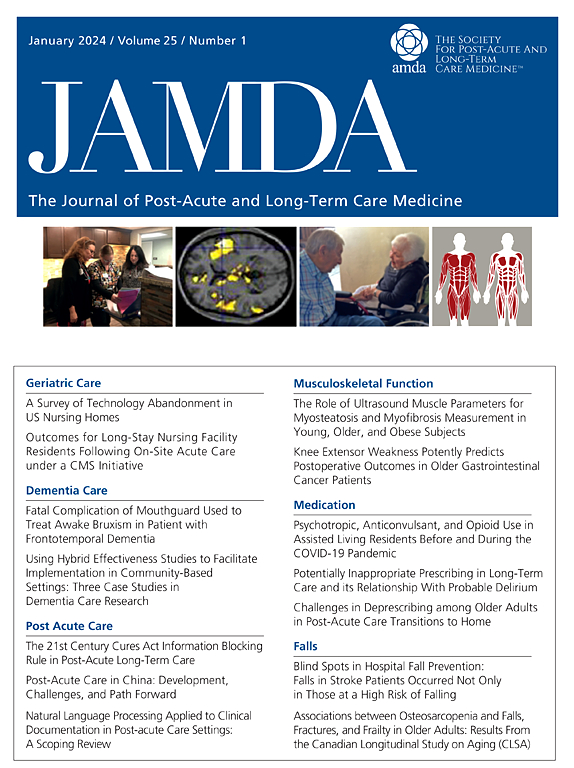Factors Associated with Mood Transitions among Older Canadian Long-Term Care Residents: A Multistate Transition Model
IF 4.2
2区 医学
Q2 GERIATRICS & GERONTOLOGY
Journal of the American Medical Directors Association
Pub Date : 2025-05-15
DOI:10.1016/j.jamda.2025.105612
引用次数: 0
Abstract
Objectives
This study examines the complex transitions between the different mood states and absorbing states out of long-term care settings, as well as the factors affecting those transitions.
Design
A retrospective longitudinal analysis of older residents in Canadian long-term care homes in 3 provinces.
Setting and Participants
Residents residing in long-term care homes in 3 Canadian provinces (Alberta, British Columbia, and Ontario) over a 10-year period from January 2010 to February 2020, with an age of at least 65.
Methods
We used a 1-step Markov multistate transition model to examine transitions in mood over time as well as the factors affecting those transitions using the standardized interRAI MDS 2.0 comprehensive health assessment. The MDS 2.0 assessments are completed by trained assessors within 2 weeks of the resident's admission.
Results
Our results showed that 46% of residents initially present with no mood disturbance on admission and 31% with mild mood disturbance on admission and 23% with moderate/severe mood disturbance on admission. Factors associated with worsening of mood include aggressive behavior; health instability; impaired cognition; major comorbidities; pain or poor sleep; conflict with family, friends, or other residents; and anxiety. Of the facility-level attributes, Alberta was associated with worsening of mood.
Conclusions and Implications
Our study identified key factors influencing mood transitions, highlighting pain and aggressive behavior as significant contributors to worsening mood, both of which are modifiable through targeted interventions. The findings suggest substantial opportunities for mood improvement in long-term care settings.
与加拿大老年长期护理居民情绪转变相关的因素:一个多州过渡模型。
目的:本研究探讨了长期护理环境中不同情绪状态和吸收状态之间的复杂转变,以及影响这种转变的因素。设计:对加拿大三个省长期护理院的老年居民进行回顾性纵向分析。环境和参与者:2010年1月至2020年2月期间,居住在加拿大3个省(阿尔伯塔省、不列颠哥伦比亚省和安大略省)长期护理院的居民,年龄至少65岁。方法:采用1步马尔可夫多状态转换模型,使用标准化的interRAI MDS 2.0综合健康评估来检查情绪随时间的转换以及影响这些转换的因素。MDS 2.0评估由训练有素的评估员在住院医师入院后两周内完成。结果:46%的住院医师入院时无情绪障碍,31%的住院医师入院时有轻度情绪障碍,23%的住院医师入院时有中度或重度情绪障碍。与情绪恶化相关的因素包括攻击性行为;健康不稳定;认知障碍;主要并发症;疼痛或睡眠不好;与家人、朋友或其他居民发生冲突;和焦虑。在设施水平属性中,阿尔伯塔与情绪恶化有关。结论和意义:我们的研究确定了影响情绪转变的关键因素,强调疼痛和攻击行为是情绪恶化的重要因素,这两者都可以通过有针对性的干预来改变。研究结果表明,在长期护理环境中,情绪改善的机会很大。
本文章由计算机程序翻译,如有差异,请以英文原文为准。
求助全文
约1分钟内获得全文
求助全文
来源期刊
CiteScore
11.10
自引率
6.60%
发文量
472
审稿时长
44 days
期刊介绍:
JAMDA, the official journal of AMDA - The Society for Post-Acute and Long-Term Care Medicine, is a leading peer-reviewed publication that offers practical information and research geared towards healthcare professionals in the post-acute and long-term care fields. It is also a valuable resource for policy-makers, organizational leaders, educators, and advocates.
The journal provides essential information for various healthcare professionals such as medical directors, attending physicians, nurses, consultant pharmacists, geriatric psychiatrists, nurse practitioners, physician assistants, physical and occupational therapists, social workers, and others involved in providing, overseeing, and promoting quality

 求助内容:
求助内容: 应助结果提醒方式:
应助结果提醒方式:


